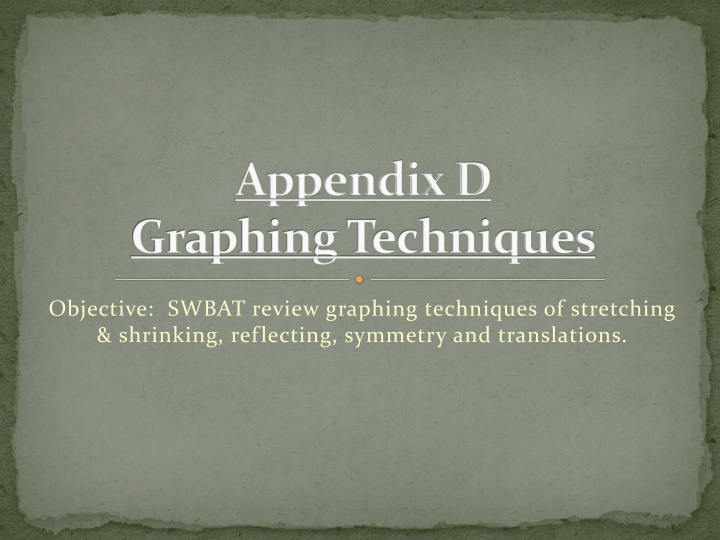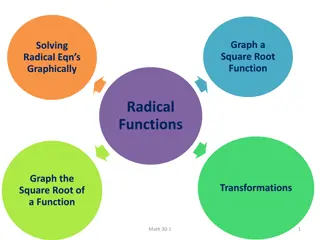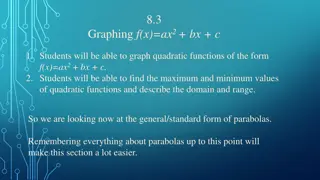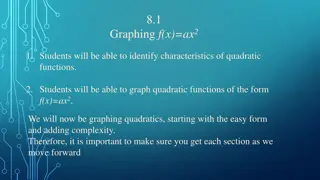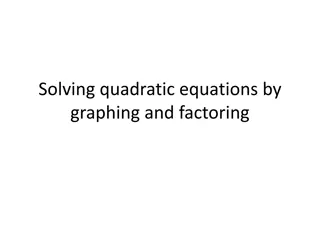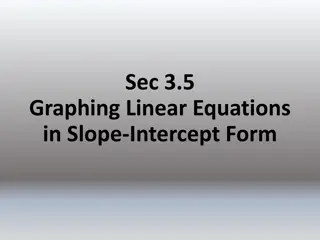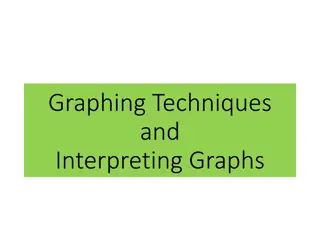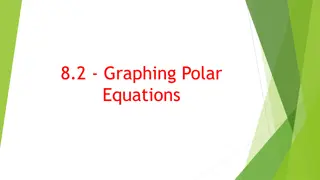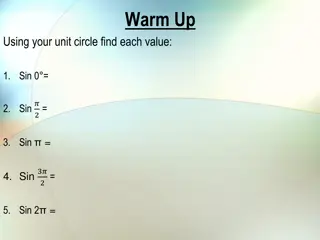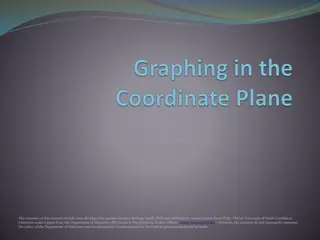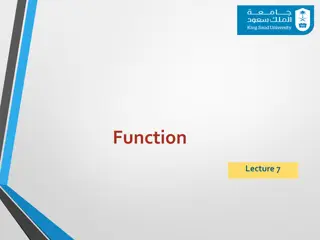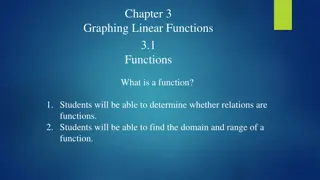Overview of Graphing Techniques and Functions
Explore graphing techniques including stretching, shrinking, reflecting, symmetry, translations, and various types of functions such as the identity function, square function, cube function, square root function, cube root function, and absolute value function. Understand vertical and horizontal shifts in graphs and how they affect functions.
Uploaded on Sep 20, 2024 | 0 Views
Download Presentation

Please find below an Image/Link to download the presentation.
The content on the website is provided AS IS for your information and personal use only. It may not be sold, licensed, or shared on other websites without obtaining consent from the author.If you encounter any issues during the download, it is possible that the publisher has removed the file from their server.
You are allowed to download the files provided on this website for personal or commercial use, subject to the condition that they are used lawfully. All files are the property of their respective owners.
The content on the website is provided AS IS for your information and personal use only. It may not be sold, licensed, or shared on other websites without obtaining consent from the author.
E N D
Presentation Transcript
Appendix D Graphing Techniques Objective: SWBAT review graphing techniques of stretching & shrinking, reflecting, symmetry and translations.
Types of Graphs: Sketch the following different types of graphs in your notebook. Graph paper is on the side table. Notice the function and what the graph looks like
Identity Function f(x)= x Domain: all reals Range: all reals
Square Function (a quadratic formula) h(x)= x2 Domain: all reals Range: [0, )
Cube Function m(x)= x3 Domain: all reals Range: all reals
Square Root Function n(x) = x Domain: [0, ) Range: [0, )
Cube Root Function p(x) = 3 x Domain: all reals Range: all reals
Absolute Value Function p(x) = x Domain: all reals Range: [0, )
Vertical Shift The graph of y = f(x) + k can be obtained from the graph of y = f(x) by vertically translating (shifting) the graph of the latter upward k units if k is positive and downward |k| units if k is negative. Graph y = |x|, y = |x| + 4, and y = |x| 5.
Horizontal Shift The graph of y = f(x + h) can be obtained from the graph of y = f(x) by horizontally translating (shifting) the graph of the latter h units to the left if h is positive and |h| units to the right if h is negative. Graph y = |x|, y = |x + 4|, and y = |x 5|.
Horizontal & Vertical Shifts If the shift happens outside the function, it is vertical. If the shift happens inside the function, it is horizontal.
Reflection, Stretches and Shrinks The graph of g(x) = a * f(x) has the same general shape as the graph of f(x). If a > 1, the result is a vertical stretch (narrower) compared to the graph of f(x). If 0 < a < 1, the result is a vertical shrink (wider) compared to the graph of f(x). If a = 1, the result is a reflection in the x axis. Graph y = |x|, y = 2|x|, y = 0.5|x|, and y = 2|x|.
Reflections h(x)= - f(x) reflects across the x axis. h(x)= f(-x) reflects across the y axis. If it happens outside the function, reflects across the x axis. If it happens inside the function, reflects across the y axis.
Symmetry The graph of f (x) is cut in half by the y-axis with each half the mirror image of the other half. A graph with this property is said to be symmetric with respect to the y-axis. As this graph suggests, a graph is symmetric with respect to the y-axis if the point (-x, y) is on the graph whenever the point (x, y) is on the graph.
Symmetry Similarly, if the graph of g (x)were folded in half along the x-axis, the portion at the top would exactly match the portion at the bottom. Such a graph is symmetric with respect to the x-axis: the point (x, -y) is on the graph whenever the point (x, y) is on the graph.
Testing for Symmetry with Respect to an axis In y = x2 +4 replace x with x 1. 2. In x = y2 - 3 replace y with y 3. In x2 +y2 = 16 substitute x for x and y for y
Symmetry Another kind of symmetry occurs when a graph can be rotated 1800 around the origin, with the result coinciding exactly with the original graph. Symmetry of this type is called symmetry with respect to the origin. A graph is symmetric with respect to the origin if the point (-x, -y) is on the graph whenever the point (x, y) is on the graph.
Testing for Symmetry with Respect to the Origin Are the following graphs symmetric with respect to the origin? + y = 2 2 16 x
Testing for Symmetry with Respect to the Origin Are the following graphs symmetric with respect to the origin? y = 3x
